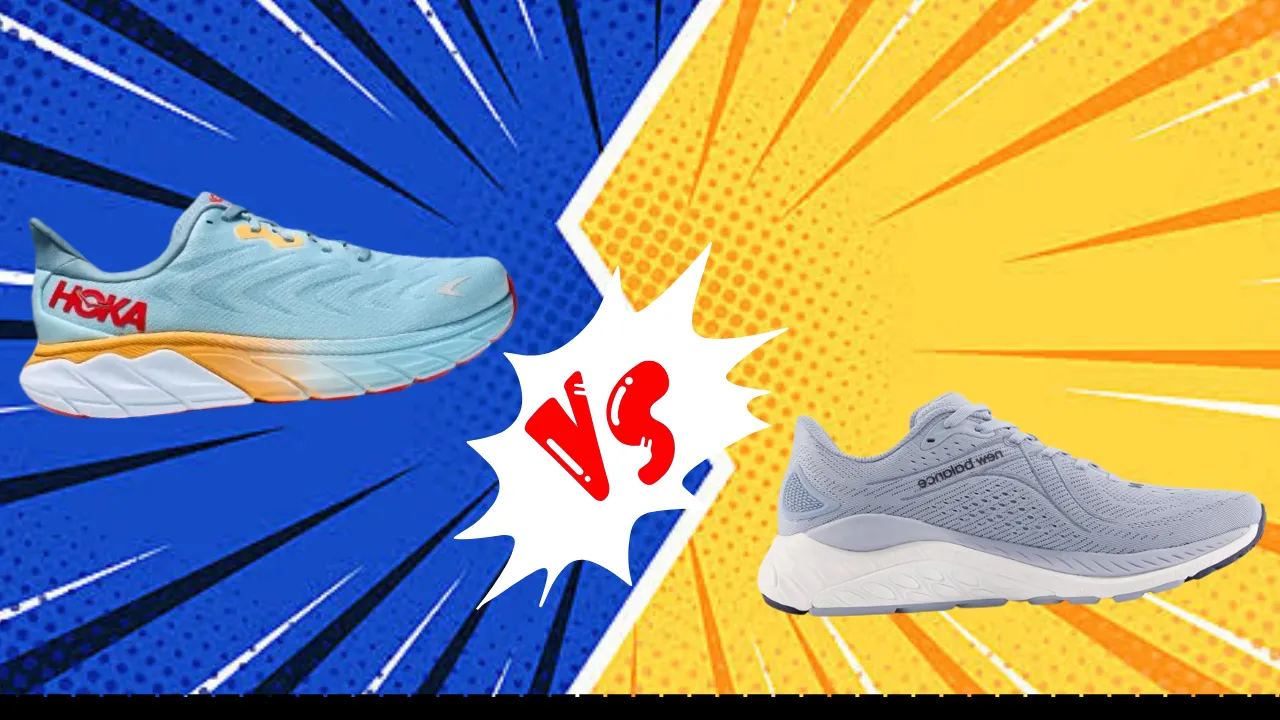The Hoka One One Arahi 6 and the New Balance 860v13 are both stability running shoes designed for runners who need moderate support and cushioning.
These lightweight trainers provide a comfortable, responsive ride and help guide overpronating runners. But how do they compare when it comes to features, fit, performance, and value? Read on to find out which stability shoe is best for you.
Similarities And Differences Between Arahi 6 and New Balance 860v13:
| Features | Hoka One One Arahi 6 | New Balance 860v13 |
|---|---|---|
| Launched In | 2022 | 2022 |
| Stability | Moderate | Moderate |
| Flexibility | Moderate | Moderate |
| Sizing | Men’s 7-15, Women’s 5-12 | Men’s 7-15, Women’s 5-12 |
| Weight | 10.2 oz (M), 8.9 oz (W) | 10.6 oz (M), 9.3 oz (W) |
| Cushion | Moderate | Moderate |
| Outsole | Durable rubber | Blown rubber |
| Midsole | J-Frame technology | Fresh Foam X |
| Upper | Engineered mesh | Engineered mesh |
| Retail Price | $140 | $140 |
Features Comparison
Materials
The outsoles on both shoes utilize rubber for durability, with the Arahi 6 using Zonal and Durabrasion rubber and the 860v13 using blown rubber. The midsoles differ, with the Arahi 6 featuring Hoka’s J-Frame technology while the 860v13 uses New Balance’s Fresh Foam X.


Both provide responsive cushioning. The uppers on each shoe are made of flexible, breathable engineered mesh. Inside, the Arahi 6 has moderate arch support while the 860v13 incorporates a medial post to prevent overpronation. The shoes are very comparable when it comes to materials.
Durability
In terms of durability, both the Arahi 6 and 860v13 are built to last, thanks to their sturdy rubber outsoles and durable mesh uppers. The Arahi’s Zonal rubber in high-wear areas helps prolong the shoe’s life. The 860v13’s blown rubber outsole is also extremely hardy.
The Fresh Foam X midsole retains its bounce for longer than standard foam. Some testers feel the Arahi 6 runs slightly small which can lead to premature wear in the toe box area. Others report the 860v13 fits true to size. Take care to select the proper size for each shoe to get the most miles out of them. Overall, both are durable options.
Fit
The Arahi 6 and 860v13 both cater to medium/semi-wide feet. The Arahi 6 runs small according to some testers, so sizing up half a size is recommended. It has a roomy toe box and secure midfoot wrap.


The 860v13 runs true to size for most. It has a spacious toe box and padded collar that locks the heel in place. The Arahi 6 offers a more personalized fit due to the lacing that allows custom tightening in the midfoot and forefoot areas. The 860v13 has a more traditional lacing system.
For overpronators, the 860v13 provides stronger medial support thanks to its prominent dual-density medial post. The Arahi 6 is better for mild overpronators or runners who want a balance of guidance and flexibility. Overall, those with medium to semi-wide feet should get an accommodating fit in both shoes.
Stability
In terms of stability, the New Balance 860v13 takes the lead with its prominent medial post made of firmer foam along the inside of the shoe. This post helps significantly reduce inward rolling of the foot for moderate to severe overpronators.
The Hoka Arahi 6 provides moderate stability through the use of its J-Frame technology – a geometry that guides the foot through the gait cycle. It offers stability while still permitting some natural movement. The Arahi 6 would work well for mild overpronators who want some support but don’t need the strong correction of the 860v13.
For runners who struggle with flat feet or arch collapse, the 860v13 would provide superior stability and arch support. Those who only need minor guidance could appreciate the softer stabilizing feel of the Arahi 6.
Cushioning
The Hoka One One Arahi 6 and the New Balance 860v13 have very comparable cushioning. Both utilize lightweight foam in the midsole to provide a responsive, cushioned ride. The Arahi 6 uses softer foam in the rear section to absorb impact while firmer foam up front promotes smooth transitions.
Testers found it provides a good balance of comfort and support. The 860v13’s Fresh Foam X midsole gives the shoe a plush yet lively feel. It has more inherent firmness than the Arahi’s midsole foam which helps support overpronators but it still delivers plenty of shock absorption.
The 860v13 would likely feel softer to heavier runners while lighter runners might prefer the forgiving cushioning of the Arahi 6. For most runners, the level of cushioning in both shoes will prove comfortable without feeling overly soft or firm.
Value
With identical $140 price tags, the Arahi 6 and 860v13 are on par when it comes to value. You get high-quality running shoes built with premium materials and technologies at a moderate price point.
The Arahi 6 appeals to runners seeking a lightweight, flexible stability shoe that can deliver miles of comfortable mileage. The 860v13 is ideal for those needing more pronounced pronation control in a durable package. The shoes are both suitable for daily training and long runs.
While serious overpronators would get better value from the 860v13, mild overpronators or runners wanting a blend of guidance and natural motion could get more value from the Arahi 6. Overall, both models deliver excellent comfort, support, and durability making them great values for stability seekers.
Performance Comparison
Walking
For walking, both the Arahi 6 and 860v13 perform well thanks to their comfortable cushioning and supportive midsoles. The Arahi 6 offers a very natural walking feel while the 860v13 feels more structured. The 860v13 may be preferable for overweight walkers who need more stability and cushioning for low-impact walking.
The Arahi 6 would suit neutral walkers wanting an everyday shoe. Both accommodate orthotics well. The wide toe boxes prevent pinching or rubbing which can happen in walking shoes. Overall, while the 860v13 edges out the Arahi 6 for walking support, the Arahi 6 is lighter and more flexible.
Running
When running, the Arahi 6 feels smoother and more responsive while the 860v13 provides more noticeable guidance. The Arahi 6 excels at moderate paces and uptempo runs where runners can use the energetic foam and rockered design to turn over quickly.
The ample forefoot cushioning keeps feet comfortable over long distances without feeling overly soft. Meanwhile, the 860v13 shines for stability seekers running longer, slower miles. The medial post and firm cushioning prevent form breakdown at slower paces associated with overpronation.
The Fresh Foam X midsole gives a lively, well-cushioned ride over marathons and half marathons. For shorter races, the Arahi 6 would likely feel snappier. Overall, both perform well – the Arahi 6 for faster training and races and the 860v13 for slower long mileage days.
Plantar Fasciitis
For runners with plantar fasciitis, the New Balance 860v13 seems preferable between the two. The moderate-to-firm cushioning works better at taking pressure off the sensitive heel and arch areas versus the softer Arahi 6. The medial post also helps support the arch to alleviate pain from strain.
Testers with plantar fasciitis found the 860v13 relieved pain points in the feet, ankles, and knees thanks to the stability it provides. The Arahi 6 lacks the extra structure some need to treat plantar fasciitis. Overall, the 860v13 is the clear choice for combating this common running injury.
Standing All Day
The plush Fresh Foam X cushioning of the New Balance 860v13 makes it the better option between the two shoes for standing all day. The soft yet supportive midsole provides excellent shock absorption and energy return to reduce foot fatigue from long hours on your feet.
The medial post also helps combat arch and heel pain by supporting the foot’s natural structure. While the Arahi 6 is reasonably comfortable, testers found the 860v13 superior at maintaining comfort and staving off foot pain and swelling during all-day standing shifts like retail or nursing. It earns the advantage for this use case.
Final Verdict
In the end, choosing between the Hoka Arahi 6 and the New Balance 860v13 comes down to your specific needs and preferences as a runner. If you are a moderate overpronator who would benefit from motion control and maximum stability, the New Balance 860v13 is likely the better choice.
Its medial post and firm cushioning prevent excessive inward rolling. However, for those with only mild overpronation who want guidance and flexibility in their ride, the Arahi 6 takes the lead with its forgiving cushioning and smooth transition.
It offers a more natural running feel. Both shoes are comfortable, durable options. For runners dealing with plantar fasciitis or who are regularly on their feet, the extra support of the 860v13 makes it the winner.
In summary, evaluate your needs and running style to decide if the structured stability of the 860v13 or the balanced ride of the Arahi 6 is the optimal pick.

